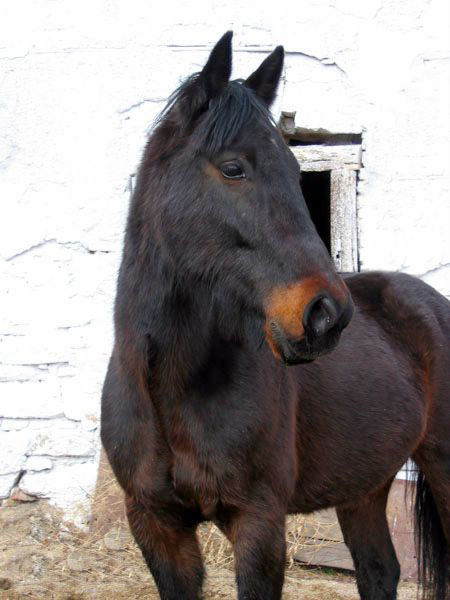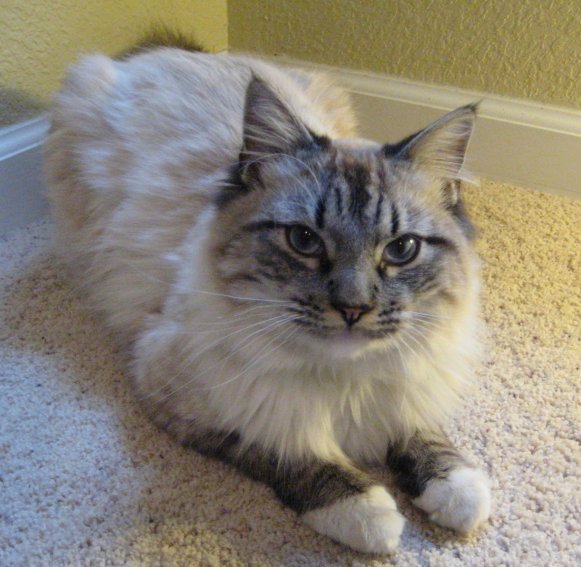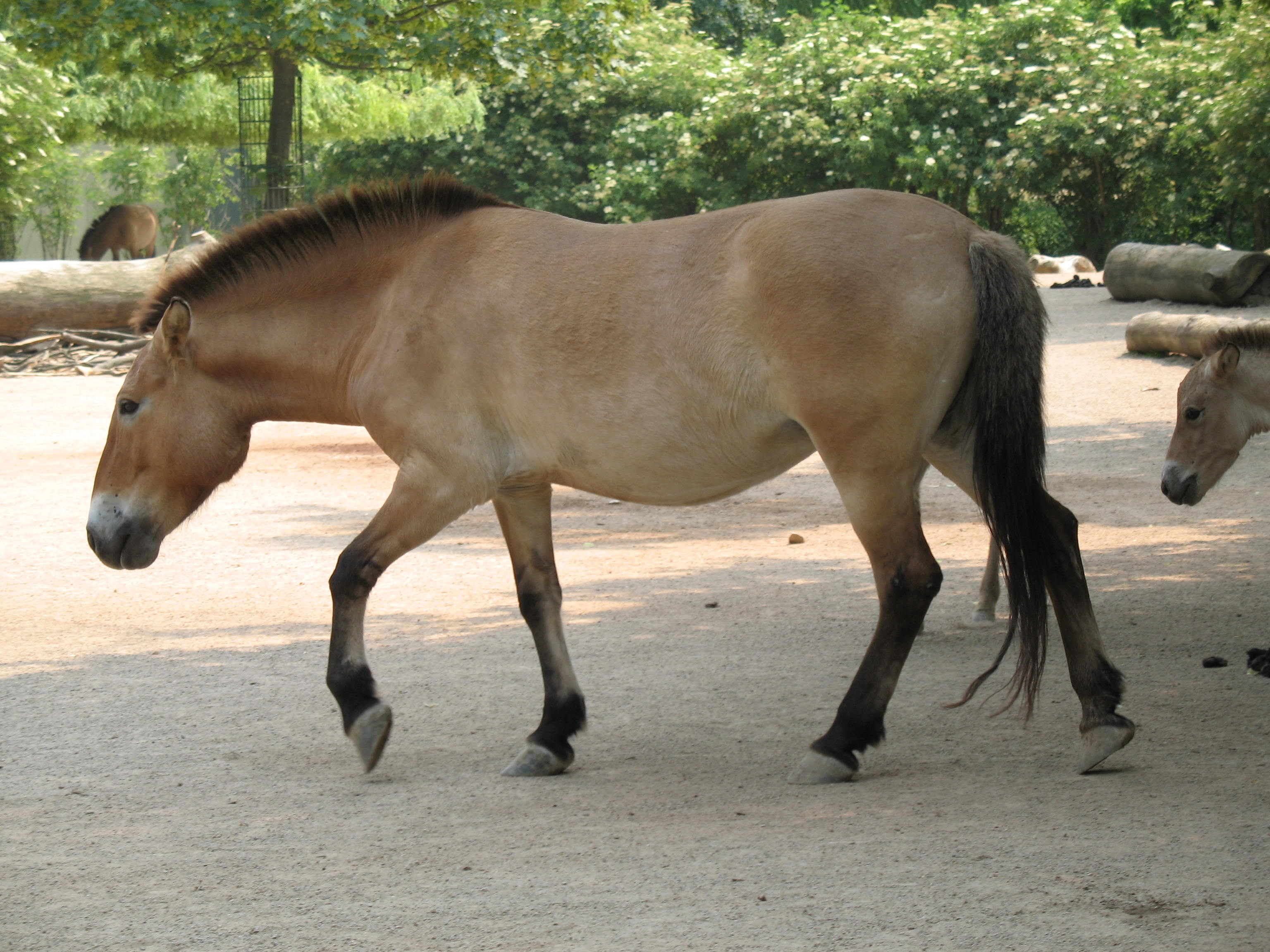|
Seal Brown (horse)
Seal brown is a hair coat color of horses characterized by a near-black body color; with black points, the mane, tail and legs; but also reddish or tan areas around the eyes, muzzle, behind the elbow and in front of the stifle. The term is not to be confused with "brown", which is used by some breed registries to refer to either a seal brown horse or to a dark bay without the additional characteristics of seal brown. Like bay, the seal brown color lacks the non-agouti mutation that would create a fully black horse. The genetics behind seal brown are not known, but some think it is caused by an allele of agouti called ''At''. A DNA test said to detect the seal brown (At) allele was developed, but the test was never subjected to peer review and due to unreliable results was subsequently pulled from the market. The similar dark bay coat color, which also features black points and a dark body, differs from seal brown by the absence of tan markings. Another mimic is the liver c ... [...More Info...] [...Related Items...] OR: [Wikipedia] [Google] [Baidu] |
Point Coloration
Point coloration refers to animal coat coloration with a pale body and relatively darker extremities, i.e. the face, ears, feet, tail, and (in males) scrotum. It is most recognized as the coloration of Siamese and related breeds of cat, but can be found in dogs, rabbits, rats, sheep, guinea pigs and horses as well. In cats Point coloration in cats originated in the Siamese and closely related Asian breeds, and is found in many Western-developed modern breeds. It is a form of partial albinism resulting from a mutation that affects tyrosinase, an enzyme involved with melanin production. The mutated enzyme is thermolabile; it fails to work at normal body temperatures, but becomes active in cooler areas of the skin. As a result, dark pigment is limited to the coldest areas of the body, that is, the extremities. Pointed kittens are born white, since the womb is uniformly warm. As the kitten ages, the cooler areas darken while warmer areas remain cream to white in color. Points a ... [...More Info...] [...Related Items...] OR: [Wikipedia] [Google] [Baidu] |
Primitive Markings
Primitive markings are a group of hair coat markings and qualities seen in several equine species, including horses, donkeys, and asses. In horses, they are associated with primitive breeds, though not limited to such breeds. The markings are particularly associated with the dun coat color family. All dun horses possess at least the dorsal stripe, but the presence of the other primitive markings varies. Other common markings may include horizontal striping on the legs, transverse striping across the shoulders, and lighter guard hairs along the edges of a dark mane and tail. Origin The dun coat and attendant primitive or "dun factor" markings reflect the wild type coat and are observed in all equine species. Some cave paintings depict horses as being dun and with the primitive markings. The Przewalski's horse is dun-colored with primitive markings. So, too, are horse breeds such as the Konik and the Heck horse, "bred back" to resemble the now-extinct tarpan, many of which ... [...More Info...] [...Related Items...] OR: [Wikipedia] [Google] [Baidu] |
Grullo
Grulla or grullo, also called blue dun, gray dun or mouse dun, is a color of horses in the dun family, characterized by tan-gray or mouse-colored hairs on the body, often with shoulder and dorsal stripes and black barring on the lower legs. In this coloration, each individual hair is mouse-colored, unlike a roan, which is composed of a mixture of dark and light hairs. The several shades of grulla are informally referred to with a variety of terms, including black dun, blue dun, slate grulla, silver grulla or light grulla, silver dun, or lobo dun. Silver grulla may also refer to a grullo horse with silver dapple, regardless of shade. In the Icelandic horse, the grulla color is called gray dun, in the Highland pony it is called mouse dun, and in the Norwegian Fjord horse, ''grå'' or ''gråblakk'' (literally, "gray dun"). The word "grulla" in Spanish means crane. Because of the origin of the name, some people will refer to a mare as a grulla and a stallion or gelding as a grull ... [...More Info...] [...Related Items...] OR: [Wikipedia] [Google] [Baidu] |
Dun Gene
The dun gene is a dilution gene that affects both red and black pigments in the coat color of a horse. The dun gene lightens most of the body while leaving the mane, tail, legs, and primitive markings the shade of the undiluted base coat color. A dun horse always has a dark dorsal stripe down the middle of its back, usually has a darker face and legs, and may have transverse striping across the shoulders or horizontal striping on the back of the forelegs. Body color depends on the underlying coat color genetics. A classic "bay dun" is a gray-gold or tan, characterized by a body color ranging from sandy yellow to reddish brown. Duns with a chestnut base may appear a light tan shade, and those with black base coloration are a smoky gray. Manes, tails, primitive markings, and other dark areas are usually the shade of the undiluted base coat color. The dun gene may interact with all other coat color alleles. Taxonomic distribution Dun is believed to be the ancestral or wild type ... [...More Info...] [...Related Items...] OR: [Wikipedia] [Google] [Baidu] |
Champagne Gene
The champagne gene is a simple dominant allele responsible for a number of rare horse coat colors. The most distinctive traits of horses with the champagne gene are the hazel eyes and pinkish, freckled skin, which are bright blue and bright pink at birth, respectively. The coat color is also affected: any hairs that would have been red are gold, and any hairs that would have been black are chocolate brown. If a horse inherits the champagne gene from either or both parents, a coat that would otherwise be chestnut is instead gold champagne, with bay corresponding to amber champagne, seal brown to sable champagne, and black to classic champagne. A horse must have at least one champagne parent to inherit the champagne gene, for which there is now a DNA test. Unlike the genes underlying tobiano, dominant white, frame overo spotting and the Leopard complex common to the Appaloosa, the champagne gene does not affect the location of pigment-producing cells in the skin. Nor does the cha ... [...More Info...] [...Related Items...] OR: [Wikipedia] [Google] [Baidu] |
Cream Gene
The cream gene is responsible for a number of horse coat colors. Horses that have the cream gene in addition to a base coat color that is chestnut will become palomino if they are heterozygous, having one copy of the cream gene, or cremello, if they are homozygous. Similarly, horses with a bay base coat and the cream gene will be buckskin or perlino. A black base coat with the cream gene becomes the not-always-recognized smoky black or a smoky cream. Cream horses, even those with blue eyes, are not white horses. Dilution coloring is also not related to any of the white spotting patterns. The cream gene (''CCr'') is an incomplete dominant allele with a distinct dosage effect. The DNA sequence responsible for the cream colors is the cream allele, which is at a specific locus on the solute carrier family 45 member 2 (''SLC45A2'') gene (previously known as ''MATP'' and ''OCA4'', among others). Its general effect is to lighten the coat, skin and eye colors. When one copy of ... [...More Info...] [...Related Items...] OR: [Wikipedia] [Google] [Baidu] |
Appaloosa
The Appaloosa is an American horse breed best known for its colorful spotted coat pattern. There is a wide range of body types within the breed, stemming from the influence of multiple breeds of horses throughout its history. Each horse's color pattern is genetically the result of various spotting patterns overlaid on top of one of several recognized base coat colors. The color pattern of the Appaloosa is of interest to those who study equine coat color genetics, as it and several other physical characteristics are linked to the leopard complex mutation (LP). Appaloosas are prone to develop equine recurrent uveitis and congenital stationary night blindness; the latter has been linked to the leopard complex. Artwork depicting prehistoric horses with leopard spotting exists in prehistoric cave paintings in Europe. Images of domesticated horses with leopard spotting patterns appeared in artwork from Ancient Greece and Han dynasty China through the early modern period. In Nort ... [...More Info...] [...Related Items...] OR: [Wikipedia] [Google] [Baidu] |
Thoroughbred
The Thoroughbred is a horse breed best known for its use in horse racing. Although the word ''thoroughbred'' is sometimes used to refer to any breed of purebred horse, it technically refers only to the Thoroughbred breed. Thoroughbreds are considered " hot-blooded" horses that are known for their agility, speed, and spirit. The Thoroughbred, as it is known today, was developed in 17th- and 18th-century England, when native mares were crossbred with imported Oriental stallions of Arabian, Barb, and Turkoman breeding. All modern Thoroughbreds can trace their pedigrees to three stallions originally imported into England in the 17th and 18th centuries, and to a larger number of foundation mares of mostly English breeding. During the 18th and 19th centuries, the Thoroughbred breed spread throughout the world; they were imported into North America starting in 1730 and into Australia, Europe, Japan and South America during the 19th century. Millions of Thoroughbreds exist today ... [...More Info...] [...Related Items...] OR: [Wikipedia] [Google] [Baidu] |
The Jockey Club
The Jockey Club is the breed registry for Thoroughbred horses in the United States and Canada. It is dedicated to the improvement of Thoroughbred breeding and racing and fulfills that mandate by serving many segments of the industry through its subsidiary companies and by supporting numerous industry initiatives. The Jockey Club, formed on February 9, 1894, is the keeper of the American Stud Book. It came into existence after James R. Keene spearheaded a drive in support of racehorse trainers who had complained about the Board of Control that governed racing in New York State. About On its formation, The Jockey Club included the existing members of the Board of Control and was overseen by seven appointed stewards. Its twenty-seven founding members included prominent and wealthy sportsmen such as Philip J. Dwyer, John A. Morris, William Kissam Vanderbilt, and William Collins Whitney. Founding officers: * Chairman - John Hunter (co-owner of Saratoga Race Course) * Vice Chair ... [...More Info...] [...Related Items...] OR: [Wikipedia] [Google] [Baidu] |
Black (horse)
Black is a hair coat color of horses in which the entire hair coat is black. Black is a relatively uncommon coat color, and it is not uncommon to mistake dark chestnuts or bays for black. True black horses have dark brown eyes, black skin, and wholly black hair coats without any areas of permanently reddish or brownish hair. They may have pink skin beneath any white markings under the areas of white hair, and if such white markings include one or both eyes, the eyes may be blue. Many black horses "sun bleach" with exposure to the elements and sweat, and therefore their coats may lose some of their rich black character and may even resemble bay or seal brown, though examination of the color of hair around the eyes, muzzle and genitals often will determine color. Black horses that do not sun bleach are called "non-fading" blacks. Some breeds of horses, such as the Friesian horse, Murgese and Ariegeois (or Merens), are almost exclusively black. Black is also common in the F ... [...More Info...] [...Related Items...] OR: [Wikipedia] [Google] [Baidu] |
Arabian Horse
The Arabian or Arab horse ( ar, الحصان العربي , DMG ''ḥiṣān ʿarabī'') is a breed of horse that originated on the Arabian Peninsula. With a distinctive head shape and high tail carriage, the Arabian is one of the most easily recognizable horse breeds in the world. It is also one of the oldest breeds, with archaeological evidence of horses in the Middle East that resemble modern Arabians dating back 4,500 years. Throughout history, Arabian horses have spread around the world by both war and trade, used to improve other breeds by adding speed, refinement, endurance, and strong bone. Today, Arabian bloodlines are found in almost every modern breed of riding horse. The Arabian developed in a desert climate and was prized by the nomadic Bedouin people, often being brought inside the family tent for shelter and protection from theft. Selective breeding for traits, including an ability to form a cooperative relationship with humans, created a horse breed that is ... [...More Info...] [...Related Items...] OR: [Wikipedia] [Google] [Baidu] |
American Paint Horse Association
The American Paint Horse Association (APHA) is a breed registry for the American Paint Horse. It is currently headquartered in Fort Worth, Texas.APHA Contact Information accessed on October 31, 2007 It was founded in 1965 with the merging of two different registries that had been formed to register -colored horses of bloodlines. One of these organizations was the American Paint Quarter Horse Association (or APQHA) and the other was the ... [...More Info...] [...Related Items...] OR: [Wikipedia] [Google] [Baidu] |










